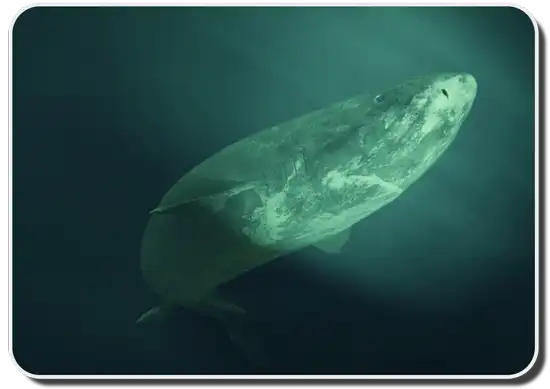
The deep ocean is the last unexplored region of the planet. We don’t know every animal that is lurking in the deep, but the creatures we do know are fascinating. The harsh environmental pressures of the deep sea have lead to some amazing evolutionary adaptations for the wide variety of sharks that live down there. Though many have similar characteristics to the sharks that live near our shores, deep water sharks have unique biological traits that have made them really interesting species. Here are seven of the coolest deep sea sharks:
1. Goblin Shark

The Goblin Shark is the oldest living species of shark on the planet and is considered a “living fossil.” It has been swimming around our deep oceans for over 125 million years. The Goblin Shark tends to live at 890-3,150 ft (270-960 m) along the upper continental slope and in deep sea canyons. However, it has been found hunting between 4,300-4,490 ft (1,300-1,370 m) under the surface. The Goblin Shark has a long slender body that is comprised mostly of fat and swims very slowly through the water. It has a long pointed snout and a retractable jaw that helps it quickly grab prey without using quick bursts of energy. The Goblin Shark’s unique biology helps it stay buoyant and silently hunt in the deep sea.
2. Frill Shark

The Frill Shark is another ancient species of shark and may be responsible for the myth of sea serpents. The Frill Shark lives at 3,300 ft (1,000 m) along the continental shelves and slopes of the Pacific and Atlantic Oceans. However, a Frill Shark was once caught at a depth of 5,150 ft (1,570 m), so scientists believe it may hunt even deeper. The Frill Shark gets its name from unusual gill filaments that form a frilled crown around its head. It has a long, eel-like body with an unusually large liver for its size that helps it stay buoyant and maneuver in the pressures of the deep water.
3. Ninja Lantern Shark
The Ninja Lantern Shark was only recently discovered in 1995 off the Pacific Coast of Central America. The Ninja Lantern Shark lives at depths of around 2,743-4,735 ft (836-1443 m). It is one of the smallest species of shark on the planet measuring in at only 12-20 in (325-515 mm) in length. What makes the Ninja Lantern Shark so unique is that it has bioluminescent organs that light up to attract and confuse prey. It’s name comes from both the ability to glow and its silent, ninja-like hunting style. These biological trait helps it be an impressive hunter in the pitch black waters of the deep ocean.
4. Bluntnose Sixgill Shark

The Bluntnose Sixgill Shark, also known as the Cow Shark, has extremely primitive features and more resembles the now extinct sharks of the Triassic Period than any of its living cousins. Like other ancient sharks it only has one dorsal fin on its lower back and large pectoral fins. Also unlike most modern shark species that only have five gill slits, the Bluntnose Sixgill Shark has six gill slits which gives the shark its name. Though the Bluntnose Sixgill Shark tends inhabit coastal waters around 300 ft (90 m), it has been recorded at depths of 6,152 ft (1,875 m). The Bluntnose Sixgill Shark practices vertical migration and will follow food sources up and down the ocean column. So though it doesn’t always live in the deep ocean, it can often be found in the deep hunting for prey.
5. Cookiecutter Shark

The Cookiecutter Shark is one of the smallest sharks in the world, growing to only 16-22 in (42-56 cm) in length. The Cookiecutter Shark hunts at nearly every ocean depth, but has been found at incredible depths of 2.3 miles (3.7 km). It gets its name from it’s usual way of feasting on prey. The Cookiecutter Shark has suctioning lips and unique teeth that helps it cut plugs of flesh out of its prey, so it can feast on animals much larger than itself. The shark also has photophores along its underside that can glow neon green, so it can attract and confuse prey in very deep waters. Though not specifically a deep water shark, this amazing shark has developed evolutionary adaptations for every depth.
6. Greenland Shark

The Greenland Shark, known for being the primary ingredient in the infamous Icelandic dish “Hakarl,” is one of the longest living sharks on the planet. Scientists estimate it can live around 200 years. This slow-moving shark has been found cruising the depths of up to 7,200 ft (2,200 m), though it typically stays around 3,900 ft (1,200 m). The Greenland Shark migrates with the seasons. It prefers colder waters so it goes deeper in the summer and higher in the winter. Like the Goblin Shark, the Greenland Shark has a flabby body and a large liver so it stays buoyant in very deep water.
7. Megamouth Shark
The Megamouth Shark is one of the largest species of shark on the planet, but because it tends to live in extremely deep water, it was only recently discovered in 1976. The Megamouth Shark is a filter feeder that preys on zooplankton. It hunts around 660 ft (200 m) deep but hunts along vertical migration patterns so some scientists think it goes much deeper. Since there have only been a few dozen specimens caught since its discovery, scientists aren’t exactly sure just how deep this shark lives.
These amazing sharks have developed some really impressive evolutionary adaptations to cope with the pressures of the deep sea. Many have only been recently discovered, so there may still be more sharks to find as we learn more about the deepest parts of the ocean.
